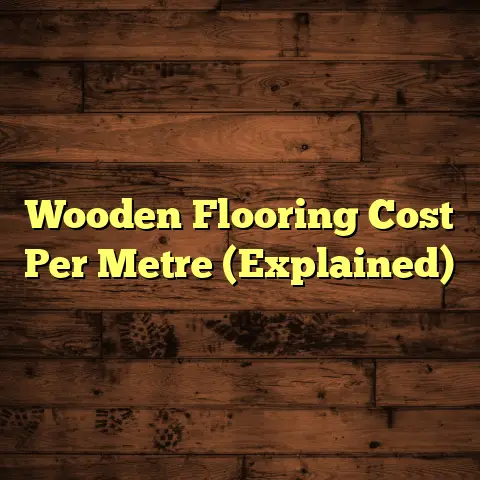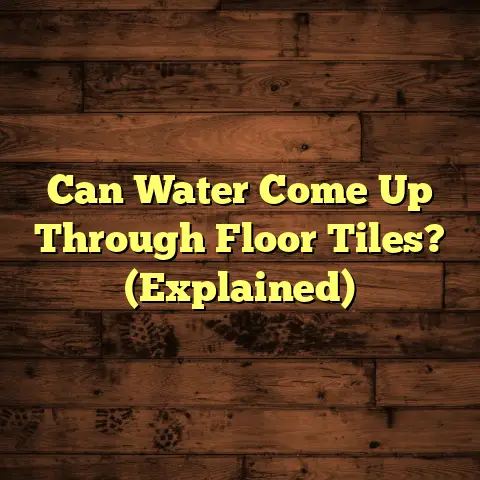Laminate Over Existing Floors? (3 Subfloor NO-NOs!)
Lots of homeowners think they can just slap it over their old floors to save time and money.
And in some cases, you can!
But hold up!
Before you grab that box of laminate, let’s talk about the subfloor.
It’s the foundation of your new floor, and if it’s not right, your laminate is going to have a bad time.
I’m going to walk you through the three biggest subfloor mistakes I see people make when installing laminate.
Avoid these, and you’ll be golden.
Mess them up, and you’ll be calling me to fix it (and that’s going to cost you!).
Section 1: Expert Picks for Laminate Flooring
1.1 Overview of Laminate Flooring Types:
Okay, so laminate isn’t just laminate.
There are different types, and choosing the right one can make a huge difference, especially when you’re going over an existing floor.
Thickness: This is a big one.
Thicker laminate (8mm, 10mm, or even 12mm) is generally more durable and better at hiding imperfections in the subfloor.
I usually recommend at least 8mm for most situations.Wear Layer: This is the top layer that protects the floor from scratches and wear.
Look for a good AC (Abrasion Class) rating.
AC3 is good for general residential use, while AC4 or AC5 is better for high-traffic areas or homes with pets.Water Resistance: Laminate isn’t waterproof, but some are more water-resistant than others.
If you’re installing in a kitchen or bathroom, look for a laminate specifically designed for wet areas.
Brands like Pergo and AquaGuard are known for their water-resistant options.Attached Underlayment: Some laminate comes with an underlayment already attached.
This can save you time and money, but make sure it’s a good quality underlayment that provides adequate cushioning and moisture protection.
My go-to brands? I’ve had great experiences with:
- Pergo: Known for durability and water resistance.
- Shaw Floors: Offers a wide variety of styles and price points.
- Mohawk: Another reliable brand with good warranties.
1.2 Benefits of Laminate Flooring:
Why is laminate so popular, anyway? Here’s the deal:
Cost-Effective: Laminate is significantly cheaper than hardwood or tile.
You can get a great look for a fraction of the price.Easy Installation: With its click-lock system, laminate is relatively easy to install yourself.
I’ve seen plenty of DIYers do a great job.Low Maintenance: Laminate is easy to clean and doesn’t require special treatments like waxing or polishing.
Just sweep or vacuum regularly and mop with a damp cloth.Durability: A good quality laminate can withstand a lot of wear and tear.
It’s resistant to scratches, dents, and fading.
I remember one client, Sarah, who had three kids and two dogs.
She was tired of her scratched-up hardwood floors.
We installed a high-quality laminate with an AC4 rating, and she’s been thrilled with how well it’s held up.
1.3 Real-world Applications:
I’ve seen laminate used successfully in all sorts of situations.
Here are a few examples:
Basement Renovation: A client of mine had a damp basement.
We installed a laminate with a waterproof core and a vapor barrier underneath.
It transformed the space into a usable living area.Kitchen Upgrade: Another client wanted to update their kitchen without breaking the bank.
We installed a water-resistant laminate that looked just like hardwood.
It was a beautiful and affordable solution.Rental Property: Laminate is a great choice for rental properties because it’s durable and easy to clean.
I’ve installed it in several apartments and condos.
Here’s a tip from my experience: Always, and I mean always, follow the manufacturer’s instructions for installation.
They know their product best, and following their guidelines will help you avoid problems down the road.
Section 2: The Importance of a Good Subfloor
2.1 What is a Subfloor?
The subfloor is the foundation upon which your new flooring rests.
Think of it as the unsung hero that provides a stable, level surface.
It’s typically made of:
Plywood: This is the most common type of subfloor, especially in homes with wood framing.
It’s relatively inexpensive and easy to work with.OSB (Oriented Strand Board): Similar to plywood, but made from compressed wood strands.
It’s often used as a subfloor in new construction.Concrete: Common in basements and slab-on-grade homes.
Concrete subfloors need to be properly prepared before installing laminate.
The subfloor’s job is to:
-
Provide a level surface: This is crucial for preventing your laminate from buckling or feeling uneven underfoot.
-
Support the weight of the flooring and traffic: A weak subfloor can lead to sagging or flexing.
-
Protect against moisture: A good subfloor will help prevent moisture from seeping up and damaging your laminate.
2.2 Why Subfloor Matters:
I can’t stress this enough: the condition of your subfloor is critical to the success of your laminate installation.
Here’s why:
Moisture: Moisture is the enemy of laminate.
If your subfloor is damp, the laminate will absorb the moisture and swell, warp, or even develop mold.Unevenness: An uneven subfloor will cause the laminate to flex and move, which can lead to broken click-lock joints and a generally unstable floor.
According to the National Wood Flooring Association (NWFA), subfloors should be flat to within 3/16″ over a 10-foot span.
That’s pretty darn flat!Structural Issues: If your subfloor is damaged or structurally unsound, it won’t provide adequate support for the laminate.
This can lead to sagging, creaking, and even complete floor failure.
I once had a client who ignored my advice and installed laminate over a slightly uneven subfloor.
Within a few months, the floor started buckling and the joints were separating.
He ended up having to tear it all out and start over.
Trust me, it’s not worth the risk.
Section 3: The 3 Subfloor NO-NOs
Okay, here’s the meat of the matter.
These are the three subfloor situations where you should never install laminate without taking corrective action:
3.1 NO-NO #1: Wet or Moisture-Prone Areas
Installing laminate over a wet or moisture-prone subfloor is a recipe for disaster.
I’m talking about:
Basements: Basements are notorious for moisture problems.
Even if you don’t see standing water, moisture can seep up through the concrete slab.Bathrooms: Bathrooms are another high-moisture area.
Leaky toilets, showers, and sinks can all contribute to a damp subfloor.-
Areas with Poor Ventilation: If an area has poor ventilation, moisture can build up over time.
How to Assess Moisture Levels:
-
Visual Inspection: Look for signs of water damage, such as stains, discoloration, or mold.
Moisture Meter: A moisture meter is a tool that measures the moisture content of wood or concrete.
You can buy one at most home improvement stores.
According to the NWFA, wood subfloors should have a moisture content of no more than 12% before installing laminate.Plastic Sheet Test: Tape a clear plastic sheet to the subfloor for 24-48 hours.
If moisture condenses under the plastic, you have a moisture problem.
The Importance of Moisture Barriers:
If you’re installing laminate in a moisture-prone area, you must use a moisture barrier.
This is a layer of plastic or other waterproof material that sits between the subfloor and the laminate.
It helps prevent moisture from seeping up and damaging the floor.
I recommend a 6-mil polyethylene film for most applications.
I had a client who insisted on installing laminate directly over a concrete slab in his basement, even though I warned him about the moisture.
A few months later, the laminate started bubbling and warping.
He had to tear it all out and install a proper moisture barrier.
Don’t make the same mistake!
3.2 NO-NO #2: Uneven or Damaged Subfloors
An uneven or damaged subfloor is another major problem. Here’s why:
-
Buckling: If the subfloor is uneven, the laminate will flex and bend, which can lead to buckling.
-
Gaps: Unevenness can also cause gaps to form between the laminate planks.
-
Broken Joints: The click-lock joints of laminate are designed to be strong, but they can break if the subfloor is uneven and puts stress on the joints.
-
Creaking: An uneven subfloor can cause the laminate to creak when you walk on it.
How to Inspect for Unevenness or Damage:
-
Visual Inspection: Look for dips, bumps, cracks, or holes in the subfloor.
Level: Use a level to check for unevenness.
Place the level on the subfloor and see if the bubble is centered.Straightedge: Use a long straightedge (at least 6 feet) to check for dips and bumps.
Place the straightedge on the subfloor and look for gaps underneath.
How to Remedy Unevenness or Damage:
Self-Leveling Compound: This is a liquid concrete mix that you pour onto the subfloor.
It flows into the low spots and creates a level surface.
This is a great option for concrete subfloors.Plywood Shims: For wood subfloors, you can use plywood shims to fill in low spots.
Simply cut the shims to the appropriate size and glue them to the subfloor.Sanding: You can sand down high spots in the subfloor.
This is a good option for minor imperfections.-
Replacing Damaged Subfloor: If the subfloor is severely damaged, you may need to replace it entirely.
I always tell my clients: “Spend the time and money to fix the subfloor before you install the laminate.
It’s much cheaper than tearing out a poorly installed floor later.”
3.3 NO-NO #3: Low-Quality or Unsupported Surfaces
Installing laminate over low-quality or unsupported surfaces is another common mistake. I’m talking about:
Old Carpet: Carpet is too soft and flexible to provide a stable base for laminate.
It will compress over time, causing the laminate to sag and buckle.Old Vinyl: Vinyl flooring can be a suitable subfloor if it’s in good condition and securely attached to the subfloor.
However, if the vinyl is loose, damaged, or has multiple layers, it needs to be removed.Particleboard: Particleboard is a low-density wood product that’s prone to moisture damage.
It’s not a good subfloor for laminate, especially in high-moisture areas.
How to Identify Unsupported Surfaces:
Check for Movement: Walk around on the existing floor and see if it feels soft or spongy.
If it does, it’s likely unsupported.Look for Damage: Check for signs of water damage, mold, or rot.
These are all signs that the subfloor is compromised.
Necessary Preparations for a Stable Installation:
Remove Old Flooring: In most cases, you’ll need to remove the old flooring before installing laminate.
This will give you a clean, stable surface to work with.-
Reinforce the Subfloor: If the subfloor is weak or unsupported, you may need to reinforce it with additional plywood or framing.
-
Add an Underlayment: Even if the laminate has an attached underlayment, I often recommend adding an additional layer of underlayment for extra cushioning and sound insulation.
I had a client who tried to save money by installing laminate over old, uneven vinyl flooring.
Within a few months, the laminate started cracking and the joints were separating.
He ended up having to tear it all out and install a new subfloor.
It was a costly mistake that could have been avoided.
Section 4: Conclusion
So, there you have it!
Laminate flooring is a great choice for many homeowners, but it’s essential to pay attention to the subfloor.
Remember these key points:
- Choose the right type of laminate: Consider thickness, wear layer, and water resistance.
- A good subfloor is crucial: It provides a level, stable, and moisture-resistant base for your laminate.
- Avoid the three NO-NOs: Don’t install laminate over wet areas, uneven surfaces, or low-quality surfaces.
By following these guidelines, you can ensure a successful laminate flooring installation that will last for years to come.
And if you’re not comfortable doing it yourself, don’t hesitate to call a professional.
It’s always better to be safe than sorry!





